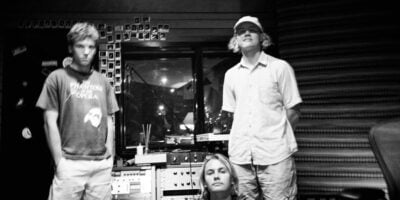Over the course of four records, Chicago-based quartet Cave have proven themselves capable of generating a vividly immersive listening experience with a seemingly very structured approach to instrumental rock. The band’s new record, Threace, again demonstrates characteristic precision. However, guitarist/organist Cooper Crain explains that a number of songs on the album were developed in the studio out of a fragmentary conceptual basis.
“We had more concepts and ideas as opposed to songs,” he says. “Most of the time it’s just like, ‘We’ve got a bunch of songs, let’s go and record them.’ This time it was a little different in the sense that, ‘We’ve got some songs and then a bunch of ideas, let’s go in and record the songs and then work on the ideas.’”
Cave have been together for over seven years and communication between the band members has become fairly intuitive, allowing them to reasonably infer what each other is thinking or motioning towards. Thanks to the group’s increased mutual understanding they’ve gained confidence in the fruits of their more spontaneous explorations.
“When it comes down to us all playing things, definitely it starts to click a lot faster these days than it did four years ago,” says Crain. “There’s a few songs on this new record where more or less what you hear on the record is the first or second or third take of just us improvising something. [By] now we’ve learned it and we’ve played it and we’ve structured it a little more by editing, but I think that’s what we were trying to capture – just the pure sense of us playing in a room.”
It can be difficult to put your faith in material that appears without any major effort, but Crain suggests a spur-of-the-moment outburst can give rise to songs with just as much depth as those that are studiously laboured over. “There’s songs that we’ve toured on for six months and [they’re] still not done, and we’ve made all these various endings or parts in the middle that we’ve taken in and out or deconstructed or rearranged for months on end. Then there’s ones where we’re like, ‘Everybody feels good right now in this room and the mics are up and it sounds cool, let’s play,’ and it’s almost equally as nice to hear. It all comes back to one point, being [if] it feels natural.”
Evidently Cave songs can originate in a variety of ways, be it a vaguely instructive brainstorm or a rough individual outline that the rest of the group sets towards realising. “Nobody ever comes to a rehearsal or a studio day with a whole song written out but somebody might have a beat or a riff or a pattern and everybody will go off of that. Or it’s just like, ‘Let’s go in there with some words written down on a piece of paper that says ‘Put mic over here,’ and then we hear how it sounds.”
Even though the band is increasingly willing to incorporate improvisation into its compositions, Crain says there remains a structured basis to the musical interaction. “Because we’ve all played with each other for a while, we understand that it’s probably going to be rhythmic, it’s probably going to be repetitive and it’s probably going to be based off a groove or a riff.”
Borne out of these processes, Threace is characterised by a lack of clutter, and the record’s circulating arrangements frequently induce a meditative state. Cave have subtly opened up more space in their music with each consecutive release and Crain emphasises that the band is determined not to meander into rock cliche.
“For us there’s always a time and place for somebody to step out and lead something, but when it comes down to the core of the group it’s everybody trying to play as simple and as open as we can, which most of the time for us is not always about a lead or somebody doing an obvious thing. It’s about building the tension and getting the audience locked in and immersed and seeing how far it goes.”
Adhering to such an aesthetic of restraint could be challenging, particularly considering Cave songs often follow a core rhythmic motif or guitar riff for upwards of seven minutes. Crain admits a good deal of patience is required to satisfy their artistic agenda. “If it does variate and it builds tension, and it might speed up or slow down, that’s a hard thing to do and everybody’s got to stay focused, whereas it’d be easy if only half the band did that and half of us were just noodling around doing a solo or something.”
Next month Cave make their long-awaited first trip to Australia. According to Crain, their live shows generally allow them to relax into the songs and conjure a sensually gripping sonic atmosphere.
“After I know a part, after I know what to do and it’s all based off of sound and how it feels with my hands, it’s easy for me to get immersed in it. I feel like I do at every show, at some point in the show or multiple times. Something will lock us in and I think if it locks us in and it keeps it interesting for us, our goal is that it keeps it interesting for the audience as well.”
BY AUGUSTUS WELBY
Threace is out now through Twelve Suns/Rocket. Cave play the Annandale Hotel on Thursday December 5.

































